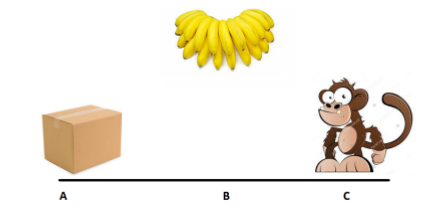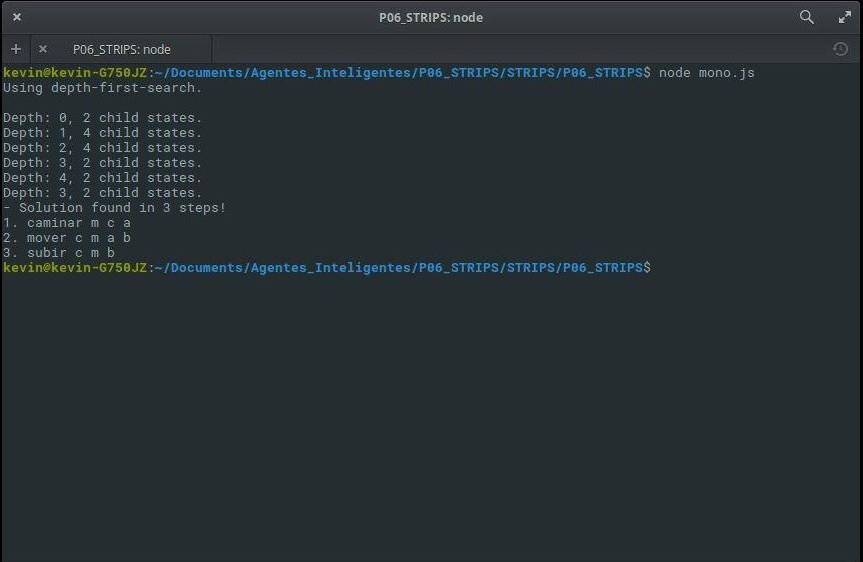Using STRIPS for helping... monkeys?

This next practice helped us to learn a bit about the planning languaje STRIPS and also about PDDL. The main goal was to solve the known monkey and banana problem by using these two languajes, alongside a javascript library which took care of the magic (or the problem?) of interpreting our two PDDL files.

In simple terms, the problem will be solved when the monkey reaches the bananas hanging from the ceiling. For this, he will be able to walk between the three “positions” in the universe - A, B or C - move the carboard box to any position, and climb it up or down.
Here, we provide the snippets for the PDDL files where we defined the problem. The strips library we used solved the problem using the depth-first search algorithm, although it can also use the A* algorithm.
problem.txt
(define (problem agarrar-bananas)
(:domain chango)
(:init (and (punto a) (punto b) (punto c) (mono m) (caja c) (bananas ba)
(en ba b) (en c a) (en m c) (abajo m) (arriba ba))
(:goal (and (en m b) (arriba m))
)
domain.txt
(define (domain chango)
(:requirements :strips)
(:action mover
:parameters (?c ?m ?i ?f)
:precondition (and (caja ?c) (punto ?i) (punto ?f) (mono ?m) (en ?m ?i) (en ?c ?i))
:effect (and (en ?c ?f)) (not (en ?c ?i)) (en ?m ?f) (not (en ?m ?i)))
)
(:action caminar
:parameters (?m ?i ?f)
:precondition (and (mono ?m) (punto ?i) (punto ?f) (abajo ?m) (en ?m ?i))
:effect (and (en ?m ?f) not (en ?m ?i))
)
(:action subir
:parameters (?c ?m ?p)
:precondition (and (mono ?m) (caja ?c) (punto ?p) (abajo ?m) (en ?m ?p) (en ?c ?p))
:effect ((arriba ?m))
)
(:action bajar
:parameters (?c ?m ?p)
:precondition (and (mono ?m) (caja ?c) (punto ?p) (arriba ?m) (en ?m ?p) (en ?c ?p))
:effect ((abajo ?m))
)
)
The code below is how we used the library for interpreting our two PDDL files (the ones above).
mono.js
var strips = require('strips');
strips.verbose = true;
// Load the domain and problem.
strips.load('./examples/mono/domain.txt', './examples/mono/problem.txt', function(domain, problem) {
// Use A* search to run the problem against the domain.
var solutions = strips.solve(domain, problem);
// Display solution.
var solution = solutions[0];
console.log('- Solution found in ' + solution.steps + ' steps!');
for (var i = 0; i < solution.path.length; i++) {
console.log((i + 1) + '. ' + solution.path[i]);
}
});
The program’s output tells us a bit about the search (information about the tree that’s being traversed), the cost of the algorithm, and the steps in order that solve the problem.

Our Conclusions
-
Adrian: I found the existing of these two languajes surprising, since the concept of “problem definition” being standarized is kinda weird for me. Regardless, I can see their uses, and of course they can, and are applied to more complex problems.
-
Felipe: I liked working with these languajes, only after I understood what I was doing! This was an interesting experience, and its an apporach of which I had no knowledge of. Always happy to keep on learning!
-
Kevin: These two languajes were pretty frustating at first, since the syntax can be a bit weird and not that intuitive. Despite that, once you get the hang of it, it becomes easier to make the definitions and think in PDDL!
Our code is totally open as always, and you can check it out!
Thanks for reading, and happy hacking!